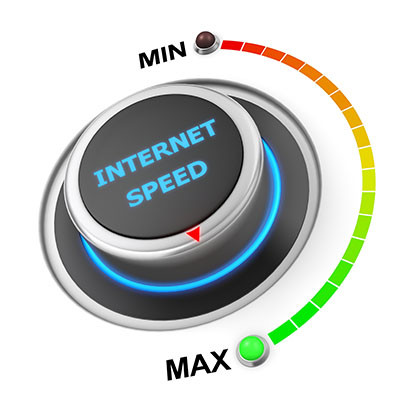Directive Blogs
The Evolution of Internet Speeds Since the 1990s
We all depend on the Internet. For most of us who have been using it since the mid-90s, we’ve seen a massive change in its use. Today, silent continuous connectivity has replaced the dial-up tones of the late 90s and early 2000s. In today’s blog, we thought we’d discuss how Internet connectivity speeds have changed over the past 30 years.
1994
The beginning of the commercial Internet does not resemble the Internet of today in any way. In the 90s, you’d sit at a desk with a keyboard, mouse, and a giant (and extremely heavy) CRT monitor that could show the user 16 colors. Computers would connect to the Internet via traditional telephone lines. The unmistakable sound of the “handshake” still haunts many of us, especially those of us who stayed on dial-up a little too long.
The standard dial-up connection was 56 kbps (kilobits per second), and while there were other methods of connectivity, they were far too expensive for most people to take advantage of at the time. To put it in perspective, if the average smartphone photo is 3.5 MB, it would take a 56kbps modem around eight minutes to fully render; and that’s with no network congestion. If it takes 480 seconds to show the picture of the cheeseburger you are about to eat or the goofy face your dog is making, sending that image becomes just impractical over that slow of a connection.
So while there was some e-commerce starting to bear its head by the beginning of the millennium, most of the websites were simple, text-based websites that users of the day marveled at. In an age where we are more frustrated by the pop-ups on the websites we visit, users of the 90s would have thought a pop-up was pretty neat.
2004
While dial-up was still a thing in 2004, most businesses and many users had moved on to broadband connections, which laid the groundwork for the modern Internet. Broadband internet was deployed through DSL or cable modem (much like today). You still needed a keyboard and mouse, but the monitors started getting thinner. At this point, there were also some mobile devices that could connect you to the web.
The 2000s broadband connection was between 256 kbps and 1 Mbps, a substantial upgrade. This allowed businesses to start thinking of the Internet as a tool to expand their offering, as web browsing was much faster. With larger connection speeds, you started to see the expansion of the Internet as a multimedia hub becoming a possibility.
You began to see the Internet-based business really take off, and the foundations of social media had been started by 2004. The growth of the Internet in this time frame was staggering as well. In 1994, only one percent of the world was using some type of Internet connection—by 2004, it was north of 14 percent. User-favorites Facebook and Gmail were launched in 2004, with YouTube coming around a year later.
2014
By 2014, we were firmly in the information age. The keyboard-and-mouse desktop computer had become less popular, while the laptop computer and mobile device had made an incredible ascent by this time. The Internet speeds of the time had to respond to the massive spike in demand for—and reliance on—the Internet. This brought innovations that allowed for what we would call today “high-speed Internet.”
With speeds between 5 Mbps and 100 Mbps, video and audio streaming became a breeze. People could share pictures and videos in an instant, and they started taking advantage of more services than ever. Online banking, managing healthcare, and the Wild West of streaming media were highlighted during this time.
The largest sector of growth during this period was mobile. Smartphones had been introduced several years before, and by 2014, there was a lot you could do on a touchscreen device. Mobile Internet (3G, 4G LTE) delivered 10 Mbps-to-50Mbps into the hands of billions of people who started using this mobile technology. In 2014, the iPhone was in its sixth generation, and Samsung had released its Galaxy S5 and Galaxy Note 4.
2024
Today’s Internet supports the mind-blowing amount of things we do in society. The development of fiber optic technology has pushed some Internet speeds past 1 Gbps. That’s just a huge leap from 56 Kbps only 30 years ago. To download a one-gigabyte file with a 56 Kbps connection, it would take a computer over a day and a half.
In 2024, downloads that would have taken several minutes only a few years ago are almost instantaneous. Today’s Internet makes sci-fi technology available from wherever you are. Most mobile platforms have moved to 5G, which at its minimum is 100 Mbps, but in many places, it is nearing or over 1 Gbps. In the very near future, 5G technology will promise revolutionary speeds with next to no latency.
This technology has people planning smart cities, networking people using virtual reality, and many more examples of the next phase of human existence. As it pertains to a business, these remarkably fast Internet speeds are creating an environment where computing can be effective for businesses purchased as-a-service, where people can connect with others in real-time on video chat while inside a file while they are sitting on opposite sides of the world. What a time to be alive.
Considering the leaps we’ve made in 30 years, it should be wild to see what the next 30 years bring. If you are interested in more technology-laden articles, please return to our blog soon.


